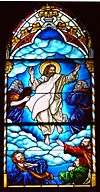Healing the paralytic at Bethesda

The Healing of a paralytic at Bethesda is one of the miraculous healings attributed to Jesus in the New Testament.[1]
This event occurs only in the Gospel of John, which says that it took place near the Sheep Gate in Jerusalem, close to a fountain or a pool called "Bethzatha" in the Novum Testamentum Graece version of the New Testament. The Revised Standard Version used the name "Bethzatha", but other versions (the King James Version and Geneva Bible) have "Bethesda". The place is called "Probatica, or in Hebrew Bethsaida", in the Douai-Rheims translation.
John's Gospel account describes how Jesus, visiting Jerusalem for a Jewish feast (John 5:1), encounters one of the disabled people who used to lie here, a man who had been paralysed for thirty-eight years. Some manuscripts of the Gospel include a passage considered by many textual critics to be an interpolation added to the original text, which explained that "an angel went down at a certain time into the pool and stirred up the water; then whoever stepped in first, after the stirring of the water, was made well of whatever disease he had" (John 5:4 - see John 5). Jesus asks the man if he wants to get well. The man explains that he is unable to enter the water when the water is stirred up, because he has no one to help in and others go down ahead of him. Jesus tells him to pick up his bed or mat and walk; the man is instantly cured and is able to do so.
The Gospel then explains that this healing took place on the Sabbath, and the local Jews told the cured man that the Law forbade him to carry his mat on this day. He tells them that he had been told to do so by the man who had healed him. They ask him who this healer was but he is unable to tell them because Jesus had slipped away into the crowd.
Later, Jesus finds the man in the Temple, and tells him not to sin again, so that nothing worse happens to him. The man goes away and tells the Jewish people that it was Jesus who had made him well (John 5:15. The Gospel account explains that the Jews began to persecute Jesus because he was healing on the Sabbath. He responds by saying that "My Father is still working, and I also am working" (John 5:17. This assertion makes the Jews all the more determined to kill him, because not only is he breaking the Sabbath but he is making himself equal to God by calling God his father (John 5:1-18).
Comparison with Acts 3
In Acts 3:1-10 a similar healing event is recorded, in which the Apostles Peter and John visit the Temple and heal a disabled person in Jesus' name. The setting is comparable, in each case a specific location in Jerusalem is named, and in each case the fact that the healed person walked away is highlighted.
See also
| Wikimedia Commons has media related to Healing at Bethesda. |
References
- ↑ The Miracles of Jesus by Craig Blomberg, David Wenham 2003 ISBN 1592442854 page 462
